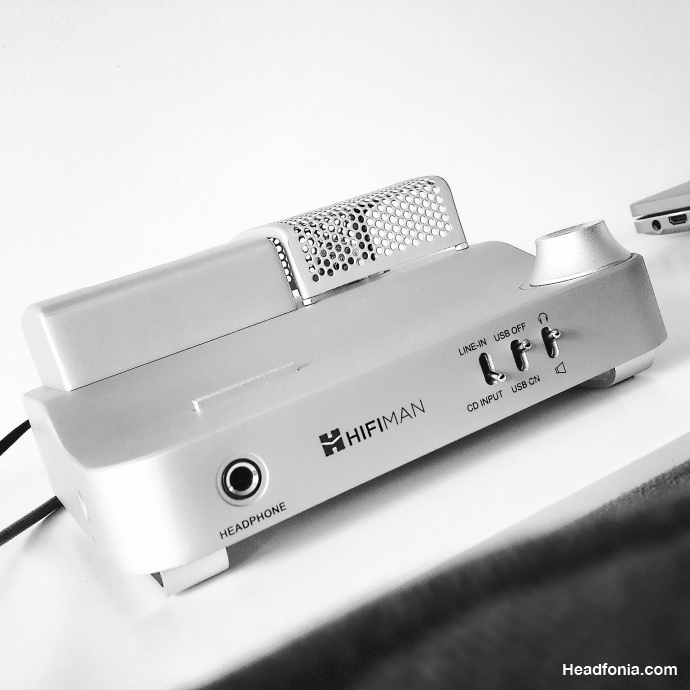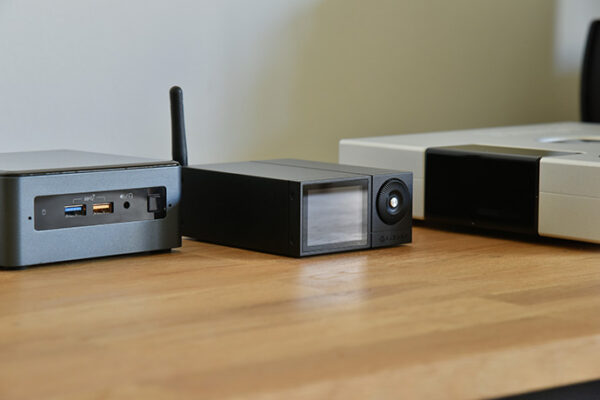Disclaimer: The Hifiman EF100 was sent to us free of charge months ago already. Hifiman also is a site advertiser.
EF-100
While this certainly isn’t the first headphone amplifier Hifiman has ever made, this is the first Hifiman amplifier I welcomed in to my home. Hifiman actually has quite some experience with amplifiers and their TOTL amplifier, the EF-6, was reviewed by a Julius on Headfonia back in December 2012 already.
The EF100 is a very versatile and powerful hybrid amplifier. Housed in its compact chassis lie three independent sections: a vacuum tube input stage that works as a shared preamp, a Class AB headphone amplifier, and a Class T speaker power amplifier. Working as a hybrid headphone amplifier, the EF100 can produce a 2w output @ 32 ohm. In addition, the EF100 can also serve as a hybrid power amplifier to drive speakers of moderate to high efficiency delivering 4.5w/channel (4 Ohm). In power amplifier mode, the amplifier output line is fully independent from the digital amplifier line used in the headphone amplifier. You could try connecting your HE-500 or HE-6 to the speaker out of the EF-100 but I personally didn’t test it. I didn’t get to test the speaker amp as my 1991 B&W speakers aren’t the most efficient speakers to say the least. At the same time you’re reading Headfonia, so testing the speaker amp part won’t interest most of you anyway. We’re headphone enthusiasts.
The single tube used in the EF100 is the 6N3J which should be replaceable with the 5670 and 396a. I do have a couple of those in my collection but all the testing was done with the stock tube. When the EF100 arrived, I was surprised to see its size. It is a lot smaller than I expected it to be going from the pictures, but it’s quite heavy with the aluminum frame used. The EF100 won’t be moving on your desk when you plug your headphone in or out, that’s for sure. I quite like the curved design of the EF100. It doesn’t draw too much attention to it in my living room and the tube is safely stored away under a removable lid. The EF100 doesn’t get hot or very warm for that matter. The EF100 is kid and cat proof. The downside is the single 6N3P doesn’t glow much so don’t expect to see that lovely tube glow in the dark.
The EF100 isn’t only a versatile amplifier but it also has different inputs: the “CD Input”, the 3.5mm line in and finally, USB. The EF100 has an integrated DAC part and the DAC chip used, if I’m not mistaken, is the Cmedia cm102. It isn’t the most modern DAC chip and it supports data up to only 16/48. For a DAC nowadays that isn’t impressive to say the least. If you don’t have an external DAC at your disposal however, the internal DAC is a nice extra. You can use the EF100 as a DAC/Amp unit or as just as an amplifier. I clearly advise to use it as an amp only.
Sound
As mentioned, all the impressions were done with the stock tube which actually turned out to be a pretty good one. The EF100 is dead silent: there is no single trace of floor noise or hiss with full sized headphones and the volume dial is completely silent too. The volume pot works with clicks and I’m hardly a fan of that. I never had the need to turn it over 8 clicks with any of my headphones yet I would have preferred a non-stepped pot or more clicks for better volume fine tuning. The internal DAC in all honesty isn’t that great and I used it mostly with the HERUS as DAC. Compared to the internal DAC that resulted in more detail and increased musicality.
It continues right after the click










Anthony Kimball
I was wondering if this amp would play nice with the Oppo headphones…It might play to their strengths.
ohm image
That’s an interesting question. Being now an owner, I’ve got to say: hmmm, interesting.
Headfonia_L.
If the OPPO needs a fast, tight and clear amp, then yes
kindergoth sissygeek
Was satisfied but not excited about my Oppo PM-1s. Wonderful build & comfort. But lacking in dynamics and excitement: and (ordinarily) I’m fond of a laid-back sound.
Switching sources (from Linn to Primare) meant I no longer had 2 analog outs. Had to use a digital S/PDIF cable between the Primare CD and my HeadRoom Portable Desktop headphone amp. The Oppos felt far stronger, immediately.
The background went from quiet to perfect silence. That–and its versatility–being the reasons I’ve relied on the HeadRoom all these years. (No experience with the EF100; sorry.)
Brad Guzman
Do you lose quality by using a different DAC going through the CD input?
Headfonia_L.
lose or gain
Brad Guzman
Lose, sorry I’m just getting into this stuff.Iin the review he said he used the HERUS and bypassed the internal DAC. So I guess my real question is how he did it? Seems like the only way to achieve that would be to have the HERUS input through the CD input of the amp.
dalethorn
You can’t do DAC twice. But if you pass along a digital signal without damaging it somehow, the DAC (or final DAC?) should be the only DAC conversion that matters, since it does the bit alignments.